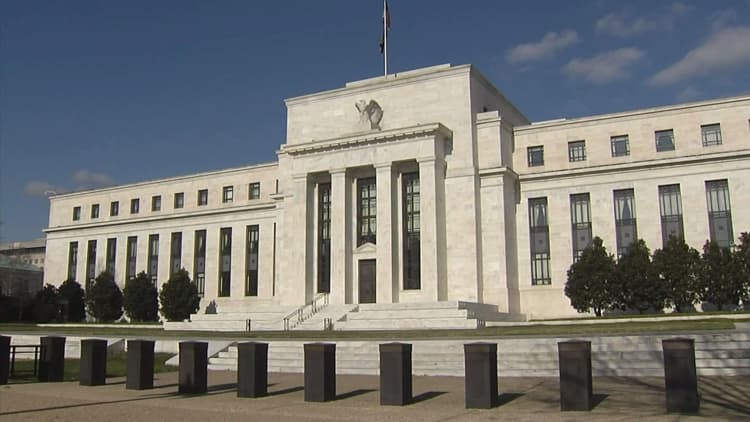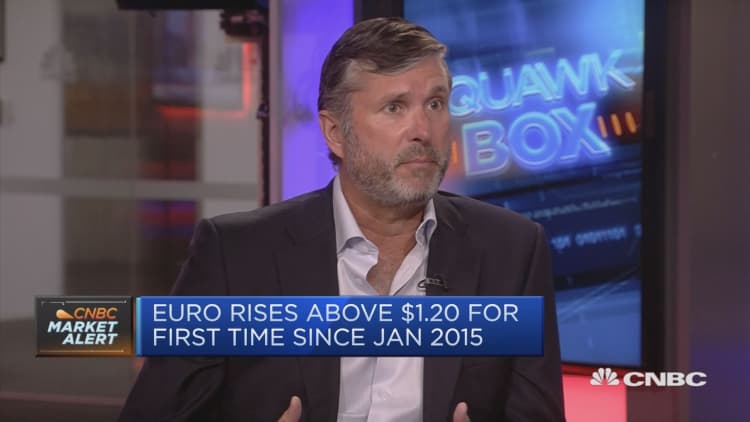Unless something dramatic happens, the Federal Reserve won't be hiking interest rates again until well into 2018, according to current market predictions.
Fed funds futures — contracts that indicate where the market thinks the central bank's benchmark rate will be — point to no further moves until at least next June, and possibly a good deal later. Futures indicate that the Fed will approve just one increase between now and the end of next year.
"The reason for that is they are not getting anywhere close to their inflation target," said Art Hogan, chief market strategist at Wunderlich Securities. "It's that sort of secular change that we've seen in inflation. We're just not going to get to 2 percent anytime soon. It keeps them at bay from being more aggressive on rates."
If the current trend holds, 2017 will mark yet another year that the Fed said it would raise rates on a consistent basis but then backed off. Should the futures market have it right, 2018 would mark an even further departure from intentions.
The most recent projections from Fed officials show anticipation of one more rate hike this year, three in 2018 and then three or four more in 2019 to bring the funds rate to around 3 percent from its current 1.16 percent [1 percent to 1.25 percent target range].
The Fed has hiked twice this year but whiffed on its projections for 2016, when it was supposed to move four times but instead approved just one increase.
Current futures trading reflects zero chance that rates will go up at the September meeting, when the policymaking Federal Open Market Committee instead likely will announce its plan to start unwinding the Fed balance sheet. The $4.5 trillion portfolio of bonds the central bank incurred during its post-financial crisis stimulus efforts will be reduced gradually over the next several years as the Fed cuts the amount of proceeds it reinvests each month.
For a good part of the year, traders had been expecting an increase at the December meeting, but that is no longer the case. Current indications are for just a 36.4 percent chance of a move, according to the CME.
In fact, there's no month until June 2018 that indicates a better-than-50 percent likelihood, and even then that is just a 51.7 percent probability, or a little better than a coin flip.
The Fed set out its intentions for this year when officials believed that President Donald Trump and Congress were committed to enacting fiscal measures that would have pushed inflation higher. Trump's agenda of tax reform, regulatory rollbacks and infrastructure spending has largely gotten held up on Capitol Hill, putting a cap on growth expectations.
"They didn't have fiscal policy to hand off to. There's not going to be that passing of the baton in terms of stimulus for this economy to shift from monetary policy to fiscal," Hogan said. "Therefore, I think both the market and the Fed have looked at this as something that needs to be delayed."
The balance-sheet question
While the rate hikes may get pushed back again, most Fed watchers expect the balance-sheet reduction to commence in October. Under a plan officials laid out in June, the Fed set caps for how much it will let roll off each month in Treasurys and mortgage-backed securities. The total will start at $10 billion a month then increase in quarterly increments until it reaches $50 billion. When all is said and done, the balance sheet likely will be cut to $2 trillion to $2.5 trillion.
While Fed Chair Janet Yellen has said the balance-sheet process won't disrupt markets, some on Wall Street are getting skeptical.
"Although the Fed's initial pace of balance-sheet slimming seems very manageable, the prospect of persistent increases in the rate of reduction could at some point produce investor concern," Zane Brown, fixed income strategist at Lord Abbett, said in a note. "Regardless of investor reaction, the normalization of the Fed's balance sheet seems likely to be 'noisier' than the uneventful outcome suggested by Fed officials, and potentially a much different experience than the 'like watching paint dry' comparison offered by Chairwoman Yellen."
Brown believes the balance-sheet reduction could push up interest rates and thus volatility. The amount of reduction exceeds the typical amount of Fed bond auction totals during the month, meaning the private sector will have to step in.
A resulting "tightening tantrum" could push bond prices down and rates up, Brown said. Fed officials themselves have acknowledged that the process will be the equivalent of a couple of rate increases.
"To the extent investors believe that equity valuations have been fueled by years of quantitative easing, while yields have been pushed to artificially low levels, it may be difficult to persuade investors that the opposite policy — quantitative tightening — will have no meaningful market impact," Brown said.


